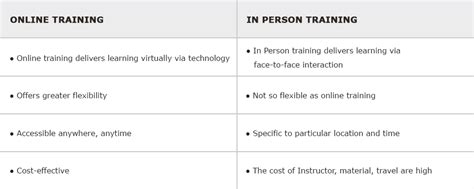Comparing Online Vs In-Person Basic Specialist Training

Explore the benefits, costs, and flexibility of online versus in-person training, along with real-world results and FAQs to guide your learning choices. In today’s fast-paced world, individuals seeking specialist training face a pivotal decision: online or in-person.
With the rise of digital platforms, online training has become increasingly popular, offering convenience and accessibility. However, traditional in-person training still holds significant value for those who prioritize personal interaction and hands-on experience. This article delves into the critical aspects of both training modalities, from understanding their unique benefits and evaluating costs to assessing flexibility and real-world outcomes.
Whether you’re a busy professional looking to enhance your skill set or a newcomer exploring your options, this comprehensive comparison will help you make an informed choice on the best training method to meet your needs. Join us as we navigate the advantages and disadvantages of online versus in-person basic specialist training.
Understanding The Benefits Of Online Training
The rise of virtual learning platforms has transformed the educational landscape, making it essential to explore the benefits of online training. One of the foremost advantages of comparing online training to traditional in-person methods is accessibility. Participants can access materials and lectures from anywhere in the world, eliminating the need for travel and allowing learners to engage at their convenience.
Another key benefit is the flexibility that online training offers. Students can often set their own pace, allowing for a more personalized learning experience. This can be particularly advantageous for those balancing work, family, or other commitments while trying to acquire new skills.
Cost-effectiveness is also notable when comparing online training options. Many online programs eliminate costs associated with commuting, accommodation, and materials typically required for in-person courses. Often, digital resources are updated more frequently and can be more readily available, reducing ongoing expenses for learners.
Moreover, online training platforms often leverage advanced technology to enhance learning experiences. Features like interactive modules, video tutorials, and online discussion forums foster engagement and promote better retention through varied learning methods.
The vast range of courses available online means that learners can find specialized training that may not be offered locally, expanding their options for skill development and career advancement. Overall, online training provides a multitude of benefits that cater to the diverse needs of today’s learners.
Evaluating In-Person Training For Personal Interaction
When it comes to comparing online and in-person basic specialist training, one of the most significant advantages of in-person training is the potential for richer personal interaction. Participants in in-person sessions often experience a more immersive learning environment, which can be critical for grasping complex concepts. The presence of a live instructor allows for immediate feedback and real-time answers to questions, enhancing the learning experience.

In-person training encourages direct communication among peers and instructors, fostering networking opportunities that can prove invaluable in professional settings. This setting allows participants to engage in discussions, share experiences, and collaborate on projects, which can deepen understanding and retention of material.
Moreover, non-verbal cues, such as body language and facial expressions, play a significant role in communication. In-person training enables participants to pick up on these cues more effectively, leading to a more engaging and interactive learning experience. This aspect can often be challenging to replicate in an online format, where video and audio quality may affect the interaction level.
However, it’s essential to note that personal interaction isn’t exclusively beneficial for all learners. Some individuals may thrive in a more self-directed online environment, where they can learn at their own pace. Thus, while evaluating in-person training, it is crucial to consider the different learning styles of participants and how they may affect the overall training experience.
Comparing Online Costs Versus In-Person Expenses
When it comes to comparing online and in-person basic specialist training, one of the most critical factors to consider is the cost. While both training methods offer unique benefits, their financial implications can significantly influence your decision.

Online training typically incurs lower costs due to the absence of physical infrastructure. Many platforms offer courses at a fraction of the price of in-person training, eliminating expenses such as:
- Travel costs for commuting to a training location.
- Accommodation fees if attending a multi-day training program.
- Meals and daily expenses while away from home.
- Potential lost income from taking time off work to attend classes.
Moreover, many providers offer free trial periods or a pay-per-course model, allowing learners to only pay for the training they choose to undertake. This flexibility can lead to significant savings.
In contrast, in-person training often requires a larger financial commitment. The costs involved include:
- Tuition fees, which are generally higher than online courses.
- Travel and accommodation expenses, if the training is not local.
- Additional materials or resources that may be required for hands-on learning.
When comparing online and in-person expenses, one must also consider the return on investment. While in-person training can provide immediate access to instructors and networking opportunities, the overall financial burden may outweigh these benefits for some learners. Conversely, online training models often cater to a broader audience, which can lead to lower costs per student.
The choice between online and in-person training will depend on individual circumstances, preferences, and the specific goals one wishes to achieve through their specialist training. It is essential to assess these factors carefully to make an informed decision.
Assessing Flexibility In Online Vs In-Person Learning
One of the most significant advantages of online training is the inherent flexibility it provides to learners. With the option to engage with courses at their own pace and on their own schedule, participants can easily balance their education with personal and professional commitments. This is especially beneficial for those who may have job obligations or family responsibilities that limit their availability during conventional class hours.
In contrast, comparing online training with in-person options highlights some of the constraints associated with traditional classroom settings. In-person training typically adheres to a fixed timetable, requiring learners to attend sessions at designated times. This can sometimes create a challenging situation for individuals who are juggling multiple responsibilities or who may need to travel long distances to attend classes.

Moreover, online training platforms often offer a wealth of resources and recorded sessions that can be accessed at any time, allowing learners to revisit materials as needed. This continuous access can lead to a deeper understanding of the content, as students can review challenging concepts without the pressure of keeping pace with a live classroom.
However, it is essential to consider that some learners may thrive better in a structured environment. In-person training fosters an atmosphere of accountability and may prevent procrastination by requiring attendance and participation. Interactive discussions, immediate feedback from instructors, and collaborative activities can enhance the learning experience for those who prefer direct engagement.
The choice between online and in-person training will depend on individual preferences, learning styles, and life circumstances. It is crucial for prospective students to evaluate their personal needs and weigh the flexibility of comparing online formats against the benefits of traditional classroom settings to determine the most suitable option for their educational goals.
Real World Results Of Comparing Online And In-Person Training
When comparing online and in-person basic specialist training, it’s essential to examine the outcomes that participants experience upon completion. Various studies and testimonials highlight the effectiveness of both training modalities, each demonstrating strengths and weaknesses based on individual learning preferences and circumstances.
Participants in online training often report greater convenience, allowing them to balance learning with their professional and personal commitments. This flexibility can lead to a more relaxed learning environment, resulting in increased retention of information and better overall performance. In fact, several surveys indicate that individuals who have completed online training programs achieve similar or even superior scores on practical assessments compared to those who attended in-person classes.
On the other hand, in-person training often provides hands-on experiences that can significantly enhance skill acquisition. The interactive nature of face-to-face classes allows for immediate feedback from instructors, which can be crucial for mastering specific techniques. Many learners find that the social component of in-person training boosts motivation and fosters networking opportunities within their industry, which may not be as easily replicated in an online setting.
Moreover, a meta-analysis of training outcomes displayed a noteworthy trend—while both modalities yield positive results, individuals with prior experience in self-directed learning tend to excel in comparing online programs. Conversely, those requiring structured guidance may thrive in a traditional classroom environment.
The decision between online and in-person training depends on personal learning styles, time availability, and professional goals. As the educational landscape evolves, ongoing research will continue to uncover more nuanced insights regarding the effectiveness of these two approaches in real-world applications.
Frequently Asked Questions
What are the main differences between online and in-person basic specialist training?
The main differences include flexibility, learning environment, interaction levels, and access to resources. Online training offers greater flexibility and convenience, while in-person training provides direct interaction and hands-on experience.
Is online basic specialist training as effective as in-person training?
Effectiveness largely depends on the individual’s learning style and the quality of the training program. Some learners may excel in an online environment, while others may benefit more from the engagement of in-person training.
What are the advantages of online basic specialist training?
Advantages of online training include flexibility in scheduling, accessibility from any location, potential cost savings, and the ability to learn at one’s own pace.
What are the benefits of in-person basic specialist training?
In-person training benefits include hands-on experience, immediate feedback from instructors, networking opportunities with peers, and a structured learning environment.
How do costs compare between online and in-person training?
Online training often has lower costs due to reduced overhead expenses, while in-person training may include additional costs such as travel, accommodation, and material fees.
Which type of training might be more suitable for interactive fields?
In-person training is often more suitable for interactive fields that require hands-on skills, collaborative projects, or real-time feedback, such as healthcare or technical trades.
Can participants switch between online and in-person training formats?
Many organizations offer hybrid training options, allowing participants to switch between online and in-person formats based on their needs and preferences.





